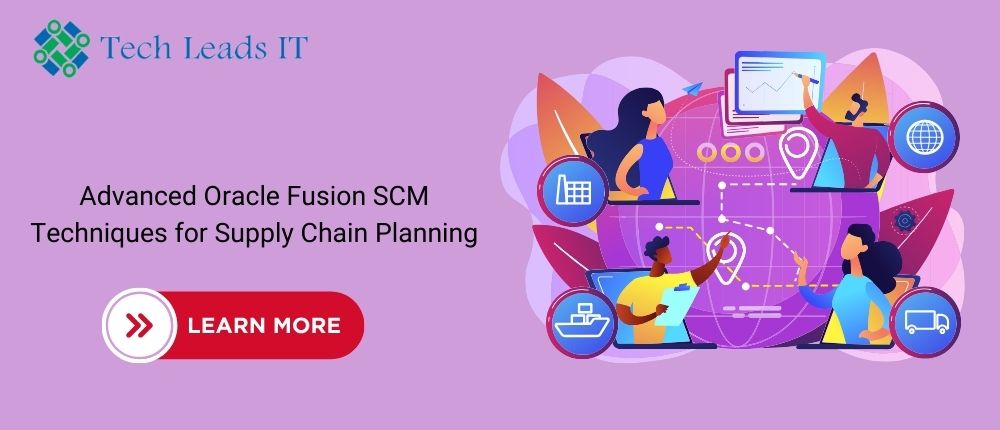Introduction
Effective supply chain planning has become more critical in today's complex global market. Organizations use sophisticated tools like Oracle Fusion SCM to optimize supply chain operations, improve forecasting accuracy, and maintain seamless inventory flows. With powerful features and modules, Oracle Fusion SCM provides businesses an integrated platform to handle everything from procurement and logistics to order management and supply chain planning. This article delves into advanced Oracle Fusion SCM techniques for supply chain planning, showcasing how Oracle Fusion SCM training can equip professionals with the skills needed to leverage these functionalities effectively.
1.Demand Planning and Forecasting
One of Oracle Fusion SCM's essential functions for supply chain planning is demand forecasting. Forecasting tools within Oracle Fusion SCM utilize advanced algorithms, historical data, and real-time insights to generate accurate demand predictions. Advanced users can leverage machine learning capabilities to analyze complex datasets, thus improving forecasting accuracy.
In Oracle Fusion SCM training, users learn to implement demand forecasting techniques to anticipate market changes, improve customer satisfaction, and reduce costs. By integrating demand data from various sources, businesses can plan production schedules, manage inventory more effectively, and reduce stockouts or overstock situations.
Key Technique: Collaborative Planning
Oracle Fusion SCM allows multiple stakeholders to participate in the planning process through collaborative planning tools. This feature ensures that different teams—marketing, production, and logistics—contribute insights that refine forecasting, leading to a more synchronized and realistic supply chain plan.
2.Supply Planning Optimization
Supply planning is another critical component that Oracle Fusion SCM addresses with precision. Effective supply planning aligns inventory levels with forecasted demand, allowing organizations to meet customer expectations without overburdening resources.
Using advanced algorithms, Oracle Fusion SCM provides scenario planning, enabling users to simulate various supply chain scenarios, including "what-if" analyses. In-depth Oracle Fusion SCM training covers how these scenario planning tools can help decision-makers prepare for uncertainties, such as supply chain disruptions or sudden shifts in demand.
Key Technique: Constraint-Based Planning
A valuable technique in supply planning is constraint-based planning. This approach considers specific constraints, such as limited capacity or budget, to create feasible plans that maximize resource utilization. Oracle Fusion SCM's constraint-based planning functionality allows planners to set parameters that ensure the plan remains realistic, which helps reduce bottlenecks and improve lead times.
3.Inventory Optimization
Inventory optimization ensures organizations maintain adequate stock levels to meet demand without excessive capital investment. Oracle Fusion SCM's advanced features support multi-echelon inventory optimization, which calculates optimal inventory levels across multiple locations or "echelons."
Inventory managers trained in Oracle Fusion SCM can make informed decisions on stocking policies, reorder points, and safety stock levels, which are essential for balancing cost efficiency and service reliability. Oracle Fusion SCM training emphasizes techniques for adjusting inventory parameters dynamically based on trends in customer demand and supplier performance.
Key Technique: Replenishment Planning
Replenishment planning within Oracle Fusion SCM considers lead times, stock levels, and consumption rates to create an efficient replenishment schedule. This technique minimizes carrying costs and ensures stock availability at the right time and place, contributing to a more streamlined supply chain.
4.Supplier Collaboration and Management
An efficient supply chain heavily relies on strong supplier relationships. Oracle Fusion SCM's Supplier Collaboration module enables real-time communication with suppliers, improving transparency, reducing lead times, and promoting a more resilient supply chain.
Advanced Oracle Fusion SCM training guides users on setting up and managing supplier portals, configuring alerts for late shipments, and collaborating on forecasts and order confirmations. This collaboration reduces uncertainty, enhancing the stability of the entire supply chain.
Key Technique: Supplier Scorecards
Oracle Fusion SCM includes tools for creating supplier scorecards, which help evaluate supplier performance based on delivery reliability, quality, and cost. By closely monitoring these metrics, businesses can identify high-performing suppliers and address issues with underperformers, fostering a reliable supply network.
5.Logistics and Transportation Planning
Logistics planning in Oracle Fusion SCM is pivotal in ensuring that goods reach their destination promptly and cost-effectively. Advanced users can streamline logistics operations by utilizing transportation management features like route optimization, carrier selection, and shipment tracking.
Oracle Fusion SCM also allows businesses to analyze the cost-effectiveness of various logistics strategies through its analytics tools. With comprehensive Oracle Fusion SCM training, users can harness these capabilities to create logistics plans that minimize transportation costs while maximizing service levels.
Key Technique: Real-Time Tracking and Analytics
Real-time tracking within Oracle Fusion SCM enables businesses to monitor shipments at every stage, providing insights essential for proactive decision-making. This data-driven approach to logistics helps organizations avoid delays and respond to disruptions quickly, leading to improved customer satisfaction and cost savings.
6.End-to-End Visibility with Advanced Analytics
Visibility is key to effective supply chain planning. Oracle Fusion SCM provides end-to-end visibility across the supply chain, helping managers monitor inventory levels, supplier statuses, production schedules, and logistics data. Advanced analytics within Oracle Fusion SCM offer dashboards and reports, allowing continuous monitoring and performance tracking.
End-to-end visibility enables businesses to identify potential issues before they escalate. With Oracle Fusion SCM training, professionals can learn to create custom reports, set up dashboards, and analyze metrics for a clearer view of supply chain health.
Key Technique: Predictive Analytics
Oracle Fusion SCM's predictive analytics allow planners to anticipate future supply chain needs based on trends and historical data. Predictive analytics improves decision-making accuracy, ensuring the right actions are taken in advance to maintain a resilient supply chain.
7.Using Machine Learning in Oracle Fusion SCM
Machine learning transforms supply chain management by automating decision-making processes and improving efficiency. Oracle Fusion SCM integrates machine learning models that can analyze vast datasets to make accurate predictions and recommendations. Advanced Oracle Fusion SCM training programs explore these machine learning capabilities, allowing supply chain professionals to identify and address inefficiencies, enhance accuracy, and reduce manual intervention.
Key Technique: Automated Forecast Adjustments
Machine learning in Oracle Fusion SCM can automate forecast adjustments based on real-time market data. This helps companies adapt quickly to fluctuations, maintain optimal inventory levels, and ensure production aligns with actual demand.
Conclusion
Oracle Fusion SCM is packed with advanced tools and techniques that enable organizations to optimize their supply chain planning processes. From demand forecasting to machine learning, Oracle Fusion SCM offers comprehensive features that make supply chain operations more efficient, adaptable, and resilient. Enrolling in Oracle Fusion SCM training equips professionals with the knowledge to leverage these capabilities fully, ensuring their organization remains competitive in an ever-evolving market. With the right skills, users can transform their supply chain strategies, ultimately driving growth, reducing costs, and achieving superior service levels.






Comments